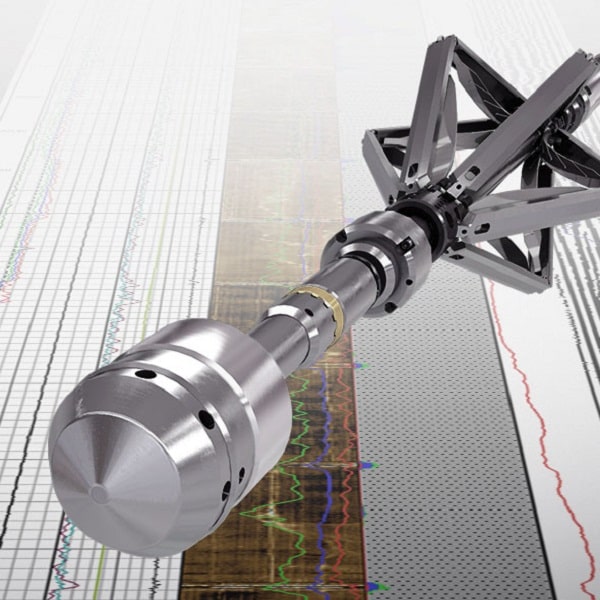This adopted report is aimed at evaluating cement integrity, casing condition and find top of cement (TOC) for the well. The report identifies with job design, Equipment preparation, and Project execution.
Introduction
A freshly drilled well is high safety/operational risk because the pressure bearing reservoirs are in direct communication with the wellbore and these pressures/fluids could find their way to the surface. At the drilling stage, the first line of preventing this reservoir pressure from getting to the surface in the drilling mud while the secondary is the Blow out preventer (BOP). Once the target drilling depth is reached and all formation evaluation measurements completed, a steel casing is run into the well and cement is used to fill up all possible spaces between the casing and the formation – this space could be referred to as annulus. This is done to firmly secure the well and its pressures downhole.
Once the casing is done and cement sets, every client is curious to know the integrity of such cement work and casing status; could there be areas without any cement? is there an open channeling in the cement path? are there areas with poor cement bond? is there any deformation to the casing? In some cases, the wells have been drilled for years and may have been transferred between clients, before doing any completion or intervention job, they would want to know the casing degradation if any and cement status as well.
The cement status is key when deciding on areas to perforate and produce from as zonal isolation of reservoir fluids is very important for operations and safety. A cement squeeze job may be required if this condition is not met. For the casing condition, any pitting or crack or deformation noticed on it suggests an issue which must be fixed before continuing operations.
Scope
The Casing & Cement Bond log involves a continuous measurement of the amplitude of sound pulses fired from a transmitter and detected by a receiver. Depending on the tool, the transmitter could be omnidirectional or directional but spinning in a 360 cycle to cover all sides of the wellbore. This amplitude detected at the receivers is at their maximum in empty or just fluid-filled annulus as they are barely attenuated while in the cement-filled annulus, detected amplitude is minimal because most of it has been attenuated by the material behind the casing.
Some properties of the wave train are used to deduce casing conditions and can also be displayed as a Variable Density Log (VDL) where the positive and negative cycles of the wave train are shaded black and white, respectively. Generally, when the acoustic wave generated by the transmitter reaches the casing,
- Part travels through the mud (fluid arrival) and refracted into the casing
- Refracted part travels through the casing (amplitude and travel-time measurement), and gets refracted to the cement
- Others are refracted into the annulus and the formation and received back (formation arrival)
A proper casing and cement job are essential: to secure the well, to support the casing, to prevent fluid from leaking to the surface, and to isolate different hydrocarbon (HC) producing zones from water-bearing zones.
Within the logging sphere, several tools with different names exist which are used for the cement bond logging. In Schlumberger, the common tool combination for this purpose is referred to as USIT-CBL (pronounced You-sit-C-B-L) and it consists mainly of an ultrasonic tool, a sonic tool, and a telemetry tool. In cases where the client only requests for the cement bond evaluation without casing information, the sonic tool can be run standalone.
Project Methodology
- Design
The successful design of any logging expedition starts with the gathering of information from the client which is used to base tool, equipment, people, and technology selections. The well in view had been drilled about forty (40) years before this casing/cement bond logging, accurate evaluation of the casing status and cement integrity was essential for any further activity to produce from the well.
Typical information requested from the client for these operations include:
- Cement Properties
- Acoustic Impedance
- Density
- Compressive Strength
- Fluid Properties
- Type and density
- Slowness and attenuation of fluid
- Acoustic Impedance
- Casing and borehole information
- Expected Top of Cement (TOC)
- Casing size, thickness, and weight
- Length of time since cement job was
Figure 1: Typical USIT-CBL tool string
- Prepare
The tool string shown in Figure 1 is what a typical USIT-CBL combination would look like, positioning of the auxiliary tools like the knuckle joints and spacers are dependent on the well
trajectory and engineer preference. The important measurements from this string would be the gamma ray (GR), the casing collar locator (CCL), and the cement/casing information. Each equipment in Figure 1 is explained below:
- LEH: Used to provide mechanical and electrical support to the tool string by connecting it to the wireline
- EDTC: Telemetry cartridge that interfaces to surface acquisition system. Also measures formation gamma ray for correlation
- CAL-Y: used to correlate by measuring the effect of casing collars on a magnetic field
- MAST: used in the basic configuration for the CBL-VDL measurement and that involves just the monopole transmitters. The same tool is used in the full configuration for formation evaluation
- GPIT: used in this string as a spacer. The inclinometry electronic cartridge is removed and replaced with a thru-wired
- AH-184: Knuckle joint to provide flexibility and reduce the maximum rigid length of the tool
- USIT: the ultrasonic tool that measures the casing properties in addition to a more qualitative CBL-VDL measurement due to its higher
In preparing the ultrasonic and sonic tools, they are put in a special pressure tank and pressurized to a specific value. A logging operation is then simulated under this pressure to check tool functionality and response to this known and controlled setup. In cases where the mud system expected is unconventional or slightly beyond the tool specifications, a sample of that mud is used in the tanks during these simulations to capture the tool response with the mud properties and any issues addressed before mobilization to location.
Figure 2: Sample setup in tank
For this project, the tools needed to run in hole centralized to the casing as eccentralization would affect the transit time response at the receivers and that would lead to a wrong interpretation of the measurements by the tool algorithms. Therefore, tool jewelery called Gemco (rigid metallic centralizers) is used along with the tool. They have to be inspected and measured to ensure they are the appropriate size for the casing expected; if the outer diameters are too small they fail to centralize, if they are too big then they could affect tool movement and get stuck downhole.
Figure 3: Gemco
As with every wireline project, the surface equipment was also prepared and verified to be in usable conditions e.g. the logging unit had the right cable and systems, the rig up equipment had valid lifting certifications, the depth and tension measuring devices were calibrated, and the hand tools are complete for the operation.
- Implementation and results
The principle the sonic tool uses for CBL-VDL measurement is similar to a ringing bell; when fluid is behind casing, the pipe is free to vibrate [loud sound] but when the casing is bonded to hard cement, casing vibrations are attenuated proportionally to the bonded surface [stifled sound]. The ultrasonic tool, however, takes it a step further by incorporating the reflections and refractions of the acoustic impedance.
Figure 4: Ultrasonic measurement
Some typical casing/cement logs are presented below, along with their interpretations.
Good cement
A good cement response has a low CBL amplitude, weak casing arrivals and strong formation VDL arrivals.
Figure 5: Good cement response
Poor cement
A poor cement job typically shows up on the log as having characteristically high CBL amplitude like ringing a bell in air. There would be strong casing arrivals with clear chevron patterns at corresponding casing collars.
Figure 6: Poor cement response
Channeling
In this scenario, the CBL amplitude varies from low to moderate-high depending on the quality of cement, however, channeling is only captured by the ultrasonic tool as the CBL too alone cannot accurately measure or show this.
Figure 7: Channeling
Damaged Casing
As previously mentioned, casing measurements are only handled by the ultrasonic tool. They show cracks, dents, corrosion, bulges and/or cave-ins. Depending on the type of damage, the cement behind may or may not be affected.
Figure 8: Casing damage
Conclusion
In this project, steps involved in planning and acquiring a casing/cement bond evaluation log in well were described. Deference in any of the steps or parameters could lead to the acquisition of false and un-useable data which would escalate into wrong decisions, loss of well control, blow out, zonal cross-talk, contamination to the environment as well as a danger to personnel, assets and equipment. As such, acquisition parameters must be selected carefully, proper tool jewelry used, right tool configuration deployed and information about the well is complete and accurate.
Recommendations
Seeing the importance of this data set, this project recommends that the Department of Petroleum Resources mandates that every oil well has at least cement bond log performed in it after running casing or before any completion for production. This will reduce the likelihood of reoccurrence of dangerous oilfield accidents often witnessed from time to time.
Contributor: Mkpouto Umana Okoko (adopted report)


















